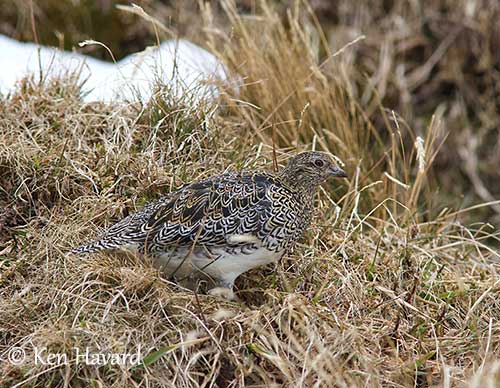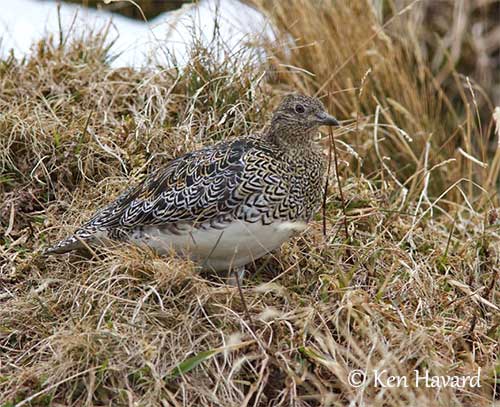
PROTECTION / THREATS / STATUS:
The White-bellied Seedsnipe is protected by both very cryptic plumage and inhospitable habitat. The species is protected in most parts of the range and also occurs in national parks.
The size of the population is unknown, but it is suspected to be stable.
The White-bellied Seedsnipe is not globally threatened and currently evaluated as Least Concern.
Fr: Attagis de Magellan
Ang: White-bellied Seedsnipe
All: Weißbauch-Höhenläufer
Esp: Agachona Patagona
Ita: Tinocoro panciabianca
Nd: Witbuikkwartelsnip
Sd: vitbukig frösnäppa
Photographer:
Ken Havard
My Bird Gallery & Flickr gallery 1 & Flickr gallery 2
Text by Nicole Bouglouan
Sources:
HANDBOOK OF THE BIRDS OF THE WORLD Vol 3 by Josep del Hoyo-Andrew Elliott-Jordi Sargatal - Lynx Edicions - ISBN: 8487334202
SHOREBIRDS by Peter Hayman, John Marchant and Tony Prater – Christopher Helm – 1986 – ISBN: 0747014035
L’ENCYCLOPEDIE MONDIALE DES OISEAUX - Dr Christopher M. Perrins - BORDAS - ISBN: 2040185607
Neotropical Birds – Cornell Lab of Ornithology
White-bellied Seedsnipe
Attagis malouinus
Charadriiformes Order – Thinocoridae Family
INTRODUCTION:
The White-bellied Seedsnipe is found in S Chile and S Argentina where it frequents barren mountains and exposed moorland. It feeds mainly on plant material, especially crowberry and buds of cacti. The nest is on the ground among the short vegetation. They form flocks in winter, and may move to lowland flats in severe weather conditions.
The White-bellied Seedsnipe usually inhabits inaccessible areas providing them a good protection against disturbances.
This species is not globally threatened for the moment.

DESCRIPTION OF THE BIRD:
Biometrics:
Length: 26-29 cm
Weight: 312-398 g
The White-bellied Seedsnipe has heavily speckled and scalloped black, buff and cinnamon upperparts, head, neck and breast, whereas chin, belly, vent, axillaries and underwings are white. Flanks and undertail feathers show irregular brown scalloping.
Head and neck may appear slightly paler, with finer pattern than on upperparts.
The bill is dark brown with greyish base of lower mandible. The eyes are brown. Legs and feet are yellowish-grey to brownish.
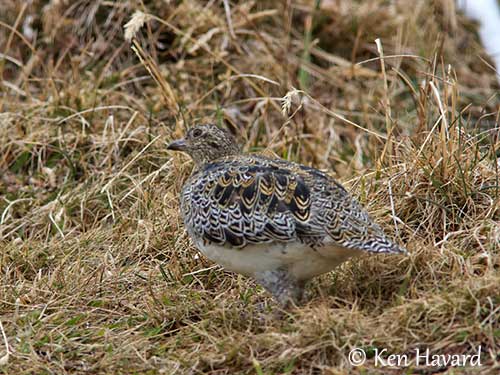
The female resembles male but we can see more or less sharp demarcation between breast and belly.
The juvenile resembles adult but the upperparts show more whitish crescents. It may appear paler, with heavier scaling than adults.
RANGE:
The White-bellied Seedsnipe is endemic to Patagonia, from Magallanes Region in S Chile and SW Río Negro in Argentina, including the Cape Horn and Wollaston Archipelago in the southern portion of Tierra del Fuego.
This species was recorded three times on Falkland Islands.
HABITAT:
The White-bellied Seedsnipe frequents scree slopes where it can find cushion vegetation, between 650 and 2,000 metres of elevation. It is usually found in barren mountains and exposed moorland with crowberry heath (Empetrum rubrum) and cushion-plants (Azorella patagonica), but also on rocky slopes crossing a small wetland.
After the breeding season, it frequents mostly the Patagonian steppes, and especially the stony part along the wide shores of partly dry lakes.
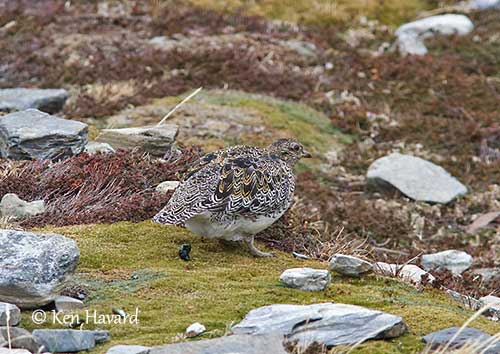
CALLS AND SONGS: SOUNDS BY XENO-CANTO
The White-bellied Seedsnipe gives a melancholy « too-ee » in flight, but when flushed, it produces a sharper, repeated “tu-whit” while performing a zigzag flight.
BEHAVIOUR IN THE WILD:
The White-bellied Seedsnipe feeds on plant material including seeds, cacti’s buds, green leaves, small berries, crowberry and cushion-plants.
It forages on the sparse vegetation growing in inhospitable mountain habitat.
The White-bellied Seedsnipe is seen in pairs in summer. The nest is on the ground and both parents take part in nesting duties.
During winter, the birds form flocks of 20-50 individuals, sometimes up to 200. They are usually gregarious outside breeding season.
This species may perform altitudinal movements during severe winters, and reaches adjacent lowland plains during heavy snow falls.
The White-bellied Seedsnipe has long, pointed wings and is agile in flight. When flushed, the bird dashes away with twisting flight involving a zigzag flight interspersed with glides. Then, it descends and lands on a high point above the surrounding area.
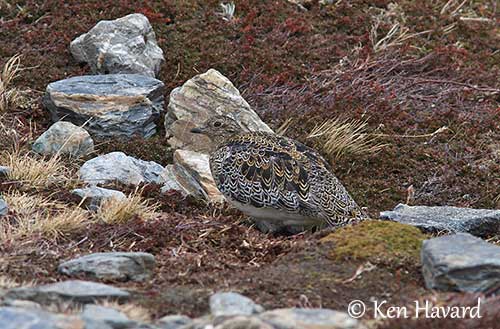
REPRODUCTION OF THIS SPECIES:
The breeding season takes place in summer, with eggs found from January. The nest density is low, and each pair uses a fairly large area with short vegetation.
The White-bellied Seedsnipe nests in a simple depression on the ground, lined with short stems, moss and lichens.
The female lays 4 yellow-olive eggs with black markings. She incubates alone while the male perches near the nest and protects it.
The downy chicks resemble adults, with scalloped upperparts and white underparts. Both parents lead them away from the nest, a few hours after hatching. The young are able to feed themselves.
When these birds are threatened, the parents usually perform distraction displays. In addition, the cryptic plumage makes them almost invisible when they crouch on the ground if an intruder is approaching.
